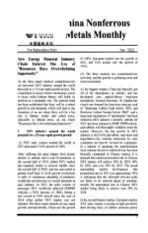It is Imperative for Chinese Enterprises to Change their Investment Model in Overseas Mining Industry
2014-08-15
By utilizing a mixed economic model, that is, state-owned companies and private companies work together to make overseas investment, complementary advantages can be leveraged to solve various drawbacks existing in the current investment in overseas mining industry.
At the 13th China Economic Forum, China Economic Weekly and China Mining Association (CMA) jointly released the 2013 Report of Overseas Investment by Chinese Enterprises in Solid Minerals. The report points out that China’s investment in overseas mining industry is still faced with the test of sustainable development.
According to the 2013 Report of Overseas Investment by Chinese Enterprises in Solid Minerals, excluding petroleum, the number of investment projects and investment amount of Chinese enterprises in solid minerals overseas in 2013 has respectively dropped by 22.78% and 45%, both showing a downward trend. Previously, the president of CMA Wang Jiahua publicly admitted that among mergers and acquisitions (M&A) concluded by Chinese mining companies overseas, about 80% have failed.
CMA’s vice president and secretary general Chen Xianda pointed out that the overseas mergers and acquisitions conducted by mining companies are different from those of general enterprises. The most critical indicator of their success is whether the project can generate continuous return of cashflow. As mining investment has the characteristic of long cycle and large size, there are also cases that the seemingly failing investment becomes successful after many years.
Therefore, the success of an investment or a M&A project cannot be simply judged by whether the project is eventually closed. “From another perspective, there should be some successful cases within the 80%; it is just that we cannot count them as success yet,” Chen Xianda remarked.
Chen Xianda told China Economic Weekly that four main reasons contribute to the high failure rate of Chinese enterprises’ investment in overseas mining industry:
Firstly, there exists blindness in Chinese enterprises’ investment in overseas mining industry. Some Chinese enterprises measure the resources value of overseas minerals using domestic standards, giving rise to stagnant mines.
Secondly, a great number of cross-industry and cross-mineral enterprises are involved in overseas mining investment, which are lacking in technical capability and industrial experience.
Thirdly, some financial institutions are not professional, misjudging market situation and underestimating investment risks.
Fourthly, some enterprises fail to strike a balance between “strategies” and “tactics”, and their investment projects are facing challenge when the price of minerals is going downward. Then, how to balance “strategies” and “tactics” to increase the success rate of overseas mining investment? Chen Xianda offered some remedies for many Chinese enterprises.
First of all, optimize investment structure. Obtain mature projects of lower risk level, shorter cycle and higher quality by merging with and acquiring foreign public mining companies. Increase acquisitions in countries with low political risk. Be cautious in investing in minerals of massive capital consumption, long cycle and high price risk, such as iron and sylvine.
Next, think carefully to define a precise positioning and to avoid just following what others are doing. Leverage the company’s own advantages, choose familiar minerals, adopt the cooperation model or investment mode that are aligned with the company’s growth strategy and get involved at the stages of prospection and development which Chinese enterprises are good at. Take care not to act hastily, and pay attention to the quality of minerals and the risk of product price fluctuation.
In addition, Chen Xianda told China Economic Weekly that there is usually a characteristic of “long term decision making and short term follow up (inspection) in overseas mining investment made by our country’s enterprises. During the decision making process, stateowned companies often miss good opportunities due to the time-consuming examination and approval procedure, while although private companies are quick in decision making, they are not good at follow up and inspection at the initial stage of the project. In this respect, Chen Xianda suggested that a mixed economic model be adopted, that is, state-owned companies and private companies work together to make overseas investment so that complementary advantages can be leveraged to solve various drawbacks existing in the current overseas mining investment, improve the quality of cooperation projects and enhance the rationality of decision making, and form the investment model of “long term tracking and quick decision making”.
杂志排行
China Nonferrous Metals Monthly的其它文章
- State Grid Plans to Invest RMB403.5 Billion in 2014, Benefiting Non-ferrous Materials
- Tibet’s Duolong Is Expected to Become a World-class Copper-Gold Mining Base
- The Ministry of Land and Resources Published the “Three-Rate” Indicator for Seven Minerals Including Iron Ore and Copper
- The Country’s New Policy Represents a Major Challenge for Lead Enterprises in Henan
- Chifeng to Build RMB200 Billion Nonferrous Metals Club
- Export Volume Increases While Price Drops: Three Major Factors Weakens Our Country’s Rare Earth Industry
